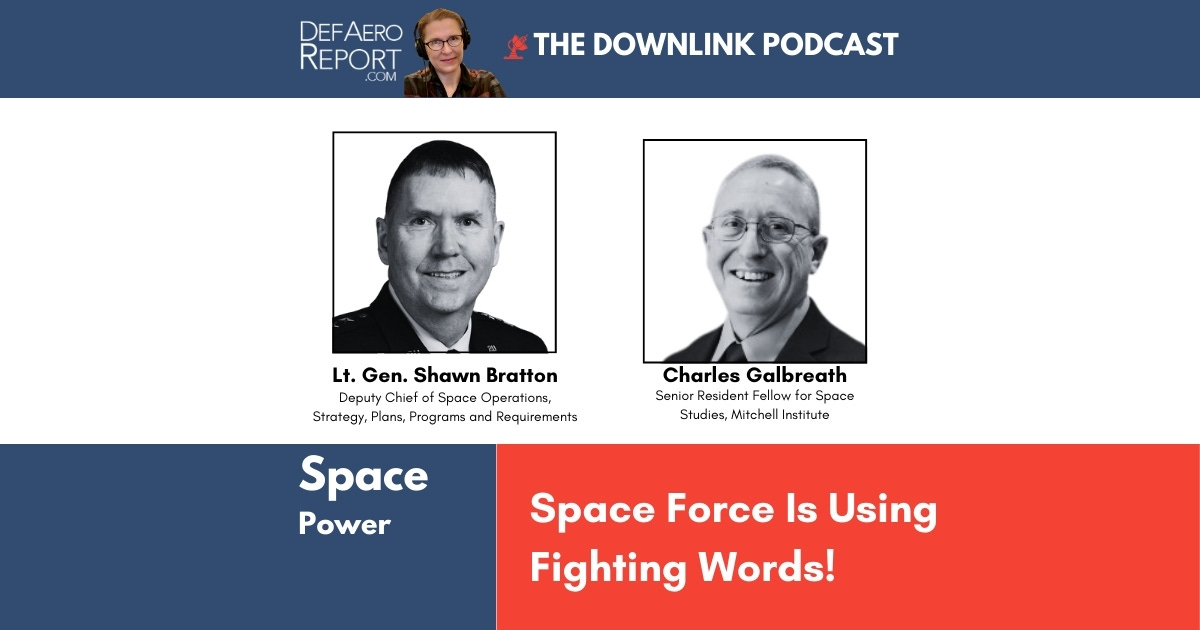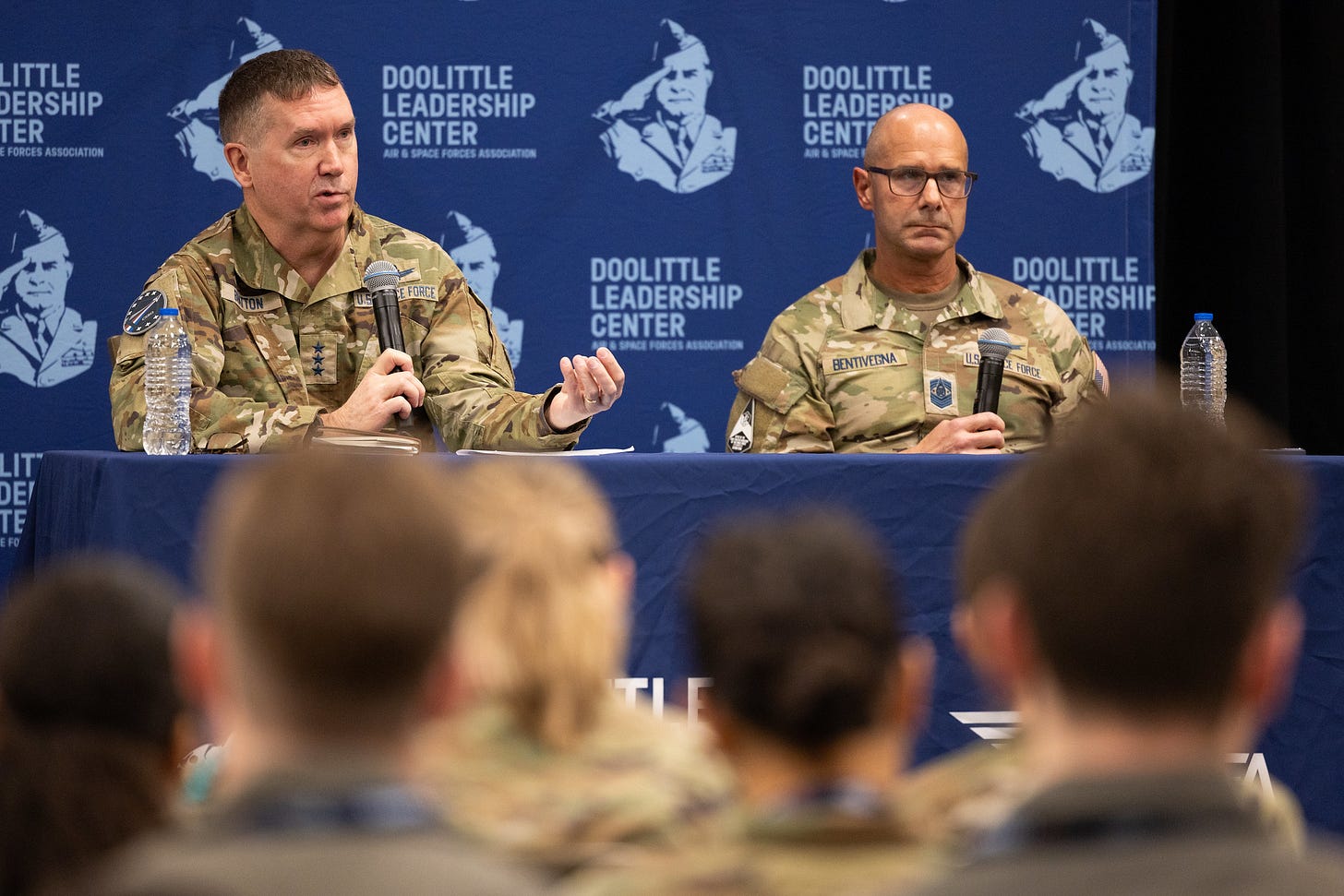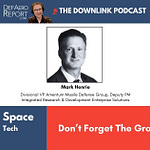Hey there! First, I must apologize for the lateness of this newsletter. It’s conference season. As I am the only one who makes this all happen, there’s a lot to do. I hope and believe you understand.
Nevertheless… Words matter, a lot.
While I am sure many of you are aware of the U.S. Space Force’s new “Space Warfighting - A Framework For Planners” document, this episode has Lt. Gen. Shawn Bratton, Deputy Chief of Space Operations, Strategy, Plans, Programs and Requirements, to explain some of the key points.
Lt. Gen. Shawn N. Bratton the Deputy Chief of Space Operations, Strategy, Plans, Programs and Requirements (left) and Chief Master Sergeant of the Space Force John F. Bentivegna attend the Doolittle Leadership Center's "Senior Mentorship for Junior Leaders" workshop at the AFA Warfare Symposium on March 4, 2025, in Aurora, Colo. Photo by Jud McCrehin/Staff
The short history of the words the U.S. Department of the Air Force has used to describe the U.S. Space Force mission, its activities, and even its aspirations, is an inharmonious collage illustrating dissonance and discord, hesitancy, subordination, leashed and stymied ambition, frustration, and much more among a large and diverse group of individuals, who at the end of the day really only want what’s best for U.S. national security.
I’m saying this up top, because this episode is sincerely not meant to throw anyone, or any group, or school of thought under the bus. That said, it’s about time that the U.S. Space Force regularized the use of words befitting a military service that has a mission statement that reads, "Secure our nation's interests in, from, and to space."
The few thoughts I’m sharing are written simply, plainly, and not nearly as elegantly as some of my thoughtful space power advocate friends who have had the benefit of a professional military education. I do so to give those who are unfamiliar the rudimentary basics to understand why this development matters; why, according to sources, only two days ago did the the Secretary of the Air Force Public Affairs office approve the use of warfighting-related terminology in public settings; and why, 10 days after the document’s publication, people are still talking about it.
Image above: U.S. Space Force Master Sgt. Patrick Pineda, U.S. Air Force Academy instructor, facilitates a capstone project inside the Multi-Domain Lab at the Air Force Academy, in Colorado, May 3, 2024. (U.S. Air Force photo by Staff Sgt. Michael Ward)
To start, space is a geographic region, like the sea, or the land, or the air. If the mission statement of a navy of any nation were to read something like "Secure our nation's interests in, from, and to the sea," you’d be pretty sure that meant ships under arms, with the right capable and disciplined folks aboard, willing and able to use all available destructive capability to secure the nation’s interests.
Take this a step further, said navy would be expected to take actions in and on the sea to hold at risk an adversary’s military capabilities that could threaten the that nation’s interests and security, and the capabilities of that nation’s sea, air, land, and space assets, regardless if those assets were military or not (think shipping). To hold something at risk necessitates not just the ability to hamper, disable, or destroy, but the willingness to prepare, to plan, and to actually do it.
And just one more wee step further, if a nation wants to deter aggression, the adversary has to be told and shown that its assets are at risk, that said navy is ready, willing, and able to destroy. This forces a nation’s adversary into doing a risk-benefit analysis that, if successful, should dissuade adversarial political leadership from employing aggression to achieve its goals.
Capt. Tamara Fumagalli, 16th Electronic Warfare Squadron, supports the Blue Cell – Space Electronic Warfare team during Chalkydri 1 at Schriever Space Force Base, Colorado, Feb. 18–21, 2025. The three-day wargame, led by Space Delta 10, evaluated command and control concepts for the space domain. (Courtesy photo)
You can’t really do all the above as well as you want unless you start using the right words. The right words lead to better concepts, to better planning and training, and to better investment and procurement, as well as inspiration for technology development.
Words matter. The other service branches have not been held back from using the right words to describe what must be done. That has made it possible for them to present a credible deterrence. For a whole basket of reasons, the Space Force has at times refrained from using particular words until now.
The words the Space Force has used in their latest publication, like “destroy” and “strike”, have been a long time coming.
Who’s in this episode
Lt. Gen. Shawn Bratton - Deputy Chief of Space Operations, Strategy, Plans, Programs and Requirements
Charles Galbreath - Senior Resident Fellow for Space Studies at the Mitchell Institute’s Spacepower Advantage Center of Excellence
Reading
“ispace Completes Success 6 of Mission 2 Milestones” - ispace press release update, April 24, 2025
“"Urbi Et Orbi" Message Of His Holiness Pope Francis” - Pope Francis, The Vatican, Easter, April 20, 2025, the day before he passed. “There can be no peace without freedom of religion, freedom of thought, freedom of expression and respect for the views of others.” Pope Francis was 88.
“Hegseth Said to Have Shared Attack Details in Second Signal Chat” - Greg Jaffe, Eric Schmitt and Maggie Haberman, New York Times, April 20, 2025.
“Hegseth’s Personal Phone Use Created Vulnerabilities” - Helene Cooper, Julian Barnes, Eric Schmitt, and Christiaan Triebert, New York Times, April 20, 2025.
“Opinion | Former Top Pentagon Spokesperson Details ‘Month From Hell’ Inside the Agency” - John Ullyot is former chief Pentagon spokesman, Politico, April 20, 2025
“Space Warfighting - A Framework For Planners” - Space Force, Department of Defense, April 17, 2025
“2 private satellites undock after pioneering life-extension mission” Andrew Jones published April 18, 2025
“Counting stars and costs: An empirical examination of space launch cost trend at NASA” - Moon J. Kim (NASA), Acta Astronautica, Volume 232, July 2025, Pages 633-639.
Have a great week. I’m in New Mexico at the State of the Space Industrial Base conference and workshop. If you’re here, let me know!
Ad Astra!
Laura















